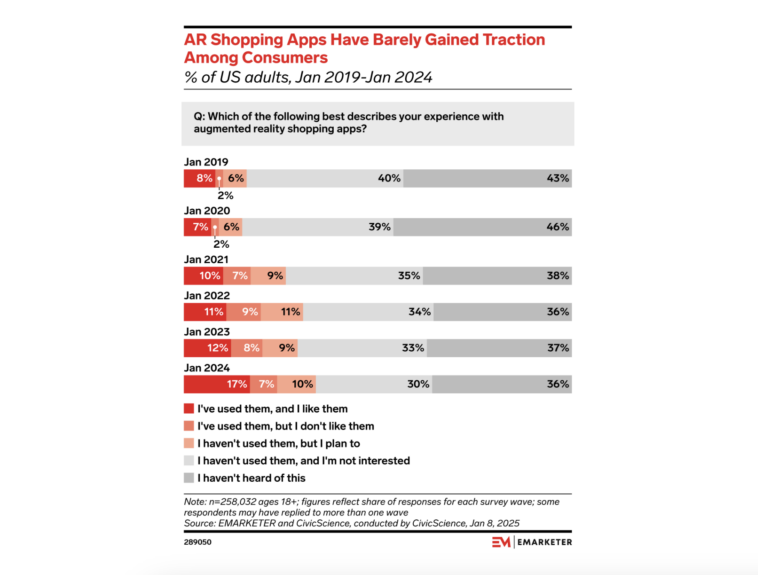Despite the growing hype around augmented reality (AR) technology, standalone AR shopping apps are failing to captivate a broad audience in the United States. Recent studies reveal that these apps have made little headway among consumers, with the majority either unaware of their existence, uninterested in their features, or having never used them. According to a January 2025 study conducted by eMarketer in collaboration with CivicScience, a staggering 66% of US adults fall into one of these categories.
The lack of consumer interest presents a significant hurdle for retailers and tech companies investing heavily in AR-based shopping solutions. Although AR technology offers innovative features like virtual try-ons, immersive product displays, and spatial visualization, it appears that many consumers are either hesitant or indifferent to adopting these tools in a standalone app format. This trend has raised questions about whether the AR shopping market can truly thrive without a paradigm shift in user engagement strategies.
A key factor contributing to the stagnation of standalone AR shopping apps is the dominance of social media platforms in the AR landscape. According to a May 2024 forecast from eMarketer, 85% of mobile AR users in the US access AR experiences via social media apps rather than dedicated shopping platforms. Social networks like Instagram, Snapchat, and TikTok have seamlessly integrated AR features, enabling users to engage with branded content, try on virtual products, and participate in interactive marketing campaigns without leaving their favorite apps.
This integration of AR within social media environments creates a frictionless experience, making it more appealing for users compared to the effort required to download and navigate separate AR shopping apps. The convenience factor, combined with the engaging nature of social media, has placed standalone AR shopping platforms at a significant disadvantage.
Despite current challenges, AR shopping is not without potential. eMarketer forecasts that AR shoppers will account for 15.3% of the US population by the end of 2025. This projected growth suggests that while adoption is slow, there remains a glimmer of hope for the industry. To capitalize on this opportunity, companies must focus on creating seamless and intuitive AR experiences that integrate more naturally into consumers’ digital routines.
One possible avenue for growth is the development of hybrid models that blend social media integration with dedicated shopping features. Retailers might also explore partnerships with major social media platforms to reach a wider audience and enhance the visibility of their AR offerings. Additionally, advancements in AR hardware and software could help lower the barriers to entry and improve user engagement.







Comments
Loading…